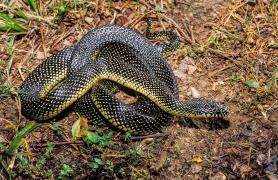These animals don’t mind a mess. In fact, they love oozy, gooey, sticky, squishy, grungy, gloppy, mucky, marvelous mud!
Mud Cranks up the Croaking
Most of the time, this spadefoot toad hides underground where it’s cool and wet. The thumb-sized amphibian digs a burrow using shovel-like spurs on its hind feet and creeps out at night to eat insects and worms. But when warm spring rains start falling, male spadefoots pop out and start calling. Their calls attract mates, and the puddles made by the rain provide a place for females to lay eggs.The eggs hatch in a few days, and the tadpoles turn quickly into young spadefoots — before the puddles dry up.
Mud makes a nice nursery
This wasp isn’t making mud balls to play buzzketball. She’s gathering mud for a nursery. The wasp flies the balls of mud, one by one, back to where she wants to build a nest. There, on the side of a building, cave, or cliff, she molds the mud into hollow tubes. When she finishes a tube,she gathers spiders and stuffs them inside. Each spider gets stung so it can’t move. The wasp lays an egg atop the pile of stunned spiders and caps the tube with mud. When the egg hatches, the baby wasp will have fresh spiders to eat.
Mud keeps critters cool
It’s hot. But this black bear can’t go inside and crank up the AC. So what’s a sun-baked bear supposed to do? Wallow in the mud, of course. Many animals — including bears, coyotes, cows, and pigs — enjoy rolling in a puddle until they’re covered from snout to tail with mud. The wet mud keeps the critter cool and comfortable. And it protects the animal’s skin from pesky flies and other bitey bugs.
Mud is a great building material
Beavers are big-league builders, fashioning dams and dens with nothing more than sticks and stones. But much of a beaver’s hard work would wash away if it weren’t for mud. Beavers gather handfuls of sticky mud and plop it down on their dams. The mud works like mortar to help hold the branches together. Beavers also plaster mud onto the sides of their dens. This forms a thick wall that keeps the den cozy and draft-free.
Mud makes nifty nests
These cliff swallows are gathering mouthfuls of mud — but not to eat. (That would be gross.) The birds mold the mud into pellets and stick the pellets to the side of a cliff (or under a bridge). Pellet by pellet, the birds build volcano-shaped nests in which to raise their babies. Some cliffs may have hundreds of nests packed together in the same spot. It takes about 1,000 pellets — and 1,000 trips to the mudhole — to finish a single nest.
Mud hides yummy things to eat
The oozy mud of a marsh is jam-packed with all sorts of creepy crawlies, such as insects, worms, and snails. Yum! Shorebirds, like this Wilson’s snipe, wade through the muck and stick their long beaks into the glop to slurp up snacks. The tip of a snipe’s super-sized schnoz can be opened while the rest of its beak stays closed. The tip is also sensitive, which helps the hungry bird detect hidden prey.
Mud provides a cozy bed
Mussels, like this elephant’s ear mussel, spend their days partially buried in the gravel, sand, and mud at the bottom of rivers and streams. These clamlike animals are filter feeders. They suck in water through a snorkel-like body part called a siphon, strain out bits of food floating in the water, and then squirt the water back out through a different siphon. By straining out lots of floaties, beds of mussels can make water cleaner.
Mud makes a good chimney
This tiny tower of mud is the front door to a crayfish’s underground home. Prairie crayfish tunnel down into soggy ground to stay cool and wet. As they dig, they use their legs and mouthparts to roll mud into little round blobs. They carry the blobs to the surface and stack them up to form small towers, which are called chimneys.
Mud has minerals
Puddle party! Butterflies like these tiger swallowtails often gather at muddy spots. The behavior is called “puddling,” but why do they do it? Biologists believe it has something to do with a butterfly’s diet. Nectar is a great fuel for fluttering, but it doesn’t provide all the nutrients a butterfly may need. To get salts and amino acids, it’s likely butterflies cluster over mud to sip up the mineral packed water.
Mud is fun
Wild critters aren’t the only animals that love mud. Humans do, too. People in the southwestern U.S. and other parts of the world build houses out of mud. Some people slather mud on their faces to make their skin soft and wrinkle-free. Rice, which more than half of the world’s people depend on for food, is grown in muddy, flooded fields.
And playing in the mud … well, that’s just good, clean fun!






















Also In This Issue

And More...
This Issue's Staff
Les Fortenberry
Karen Hudson
Angie Daly Morfeld
Noppadol Paothong
Marci Porter
Mark Raithel
Laura Scheuler
Matt Seek
David Stonner
Nichole LeClair Terrill
Stephanie Thurber
Cliff White






















